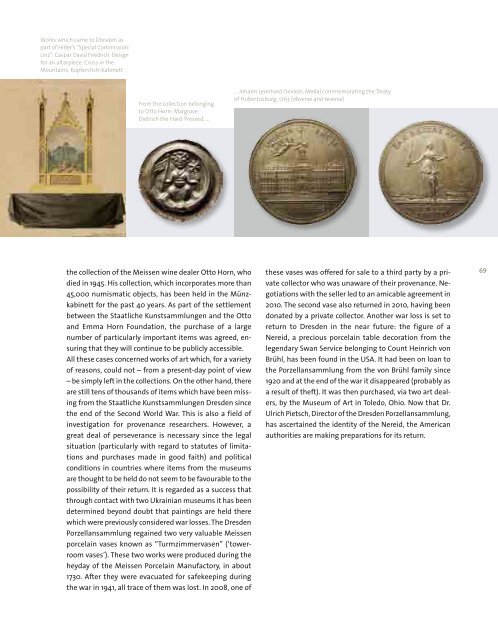Annual Report 2010 - Staatliche Kunstsammlungen Dresden
Annual Report 2010 - Staatliche Kunstsammlungen Dresden
Annual Report 2010 - Staatliche Kunstsammlungen Dresden
You also want an ePaper? Increase the reach of your titles
YUMPU automatically turns print PDFs into web optimized ePapers that Google loves.
Works which came to <strong>Dresden</strong> as<br />
part of Hitler’s “special Commission:<br />
Linz”: Caspar David Friedrich, Design<br />
for an altarpiece: Cross in the<br />
Mountains, Kupferstich-Kabinett<br />
From the collection belonging<br />
to Otto Horn: Margrave<br />
Dietrich the Hard-Pressed, …<br />
the collection of the Meissen wine dealer Otto Horn, who<br />
died in 1945. His collection, which incorporates more than<br />
45,000 numismatic objects, has been held in the Münzkabinett<br />
for the past 40 years. As part of the settlement<br />
between the <strong>Staatliche</strong> <strong>Kunstsammlungen</strong> and the Otto<br />
and Emma Horn Foundation, the purchase of a large<br />
number of particularly important items was agreed, ensuring<br />
that they will continue to be publicly accessible.<br />
All these cases concerned works of art which, for a variety<br />
of reasons, could not – from a presentday point of view<br />
– be simply left in the collections. On the other hand, there<br />
are still tens of thousands of items which have been missing<br />
from the <strong>Staatliche</strong> <strong>Kunstsammlungen</strong> <strong>Dresden</strong> since<br />
the end of the Second World War. This is also a field of<br />
investigation for provenance researchers. However, a<br />
great deal of perseverance is necessary since the legal<br />
situation (particularly with regard to statutes of limitations<br />
and purchases made in good faith) and political<br />
conditions in countries where items from the museums<br />
are thought to be held do not seem to be favourable to the<br />
possibility of their return. It is regarded as a success that<br />
through contact with two Ukrainian museums it has been<br />
determined beyond doubt that paintings are held there<br />
which were previously considered war losses. The <strong>Dresden</strong><br />
Porzellansammlung regained two very valuable Meissen<br />
porcelain vases known as “Turmzimmervasen” (‘towerroom<br />
vases’). These two works were produced during the<br />
heyday of the Meissen Porcelain Manufactory, in about<br />
1730. After they were evacuated for safekeeping during<br />
the war in 1941, all trace of them was lost. In 2008, one of<br />
… Johann Leonhard Oexlein, Medal commemorating the Treaty<br />
of Hubertusburg, 1763 (obverse and reverse)<br />
these vases was offered for sale to a third party by a private<br />
collector who was unaware of their provenance. Negotiations<br />
with the seller led to an amicable agreement in<br />
<strong>2010</strong>. The second vase also returned in <strong>2010</strong>, having been<br />
donated by a private collector. Another war loss is set to<br />
return to <strong>Dresden</strong> in the near future: the figure of a<br />
Nereid, a precious porcelain table decoration from the<br />
legendary Swan Service belonging to Count Heinrich von<br />
Brühl, has been found in the USA. It had been on loan to<br />
the Porzellansammlung from the von Brühl family since<br />
1920 and at the end of the war it disappeared (probably as<br />
a result of theft). It was then purchased, via two art dealers,<br />
by the Museum of Art in Toledo, Ohio. Now that Dr.<br />
Ulrich Pietsch, Director of the <strong>Dresden</strong> Porzellansammlung,<br />
has ascertained the identity of the Nereid, the American<br />
authorities are making preparations for its return.<br />
69

















